Wireless
The 6G Network Is On the Horizon
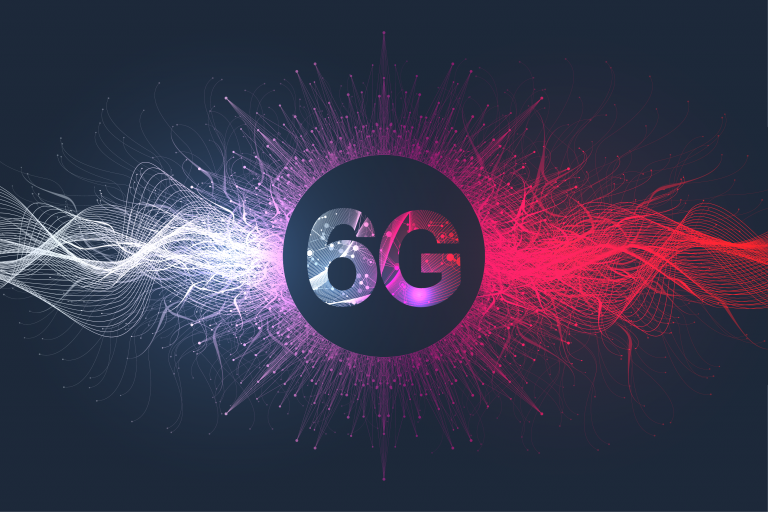
Key Points
- In its work to develop 6G, the industry has new opportunities to reconsider the service and design requirements of seamless connectivity and convergence.
- Careful consideration of this next generation of mobile technologies will result in more efficient and simplified integration of the wireline and mobile industries.
- The first specifications of 5G Advanced, which will bridge the evolution from 5G to 6G, are expected this year.
Every decade, a new generation of mobile technologies, known as “G,” is developed, along with its own set of capabilities. Recently, the ITU Radiocommunication Sector (ITU-R) unveiled its IMT-2030/6G vision, which outlines capabilities of the 6G network built on top of its earlier IMT-2020/5G vision. The initial standards for the IMT-2030/6G vision are expected to be available around 2029.
The initial release of 5G became available around 2018. Although the 5G buildout is still in progress, the industry has already started discussing 6G. The 3rd Generation Partnership Project (3GPP) decided that Release 21 would be the first release of its 6G specification work. The exact schedule for Release 21 is still under consideration, but 3GPP is looking to hold a 6G workshop in March 2025, targeting the first 6G study package for approval in June 2025. This year, 3GPP will begin deliberating 6G service requirements.
So, 6G is not on the distant horizon! It’s closer than you think.
The broadband industry has been actively working toward fixed-mobile convergence and multi-access seamless connectivity in 5G design. However, the intent of incorporating such design principles may have created unforeseen complexities and introduced optional features that may have impacted commercialization timelines. Now that we have another design opportunity with 6G, we can reconsider major service/design requirements of seamless connectivity and convergence so that 6G design considers those from the start and incorporates them as integral components to the 6G architecture.
The use cases and capabilities we can expect from 6G are shown in the graphics below.
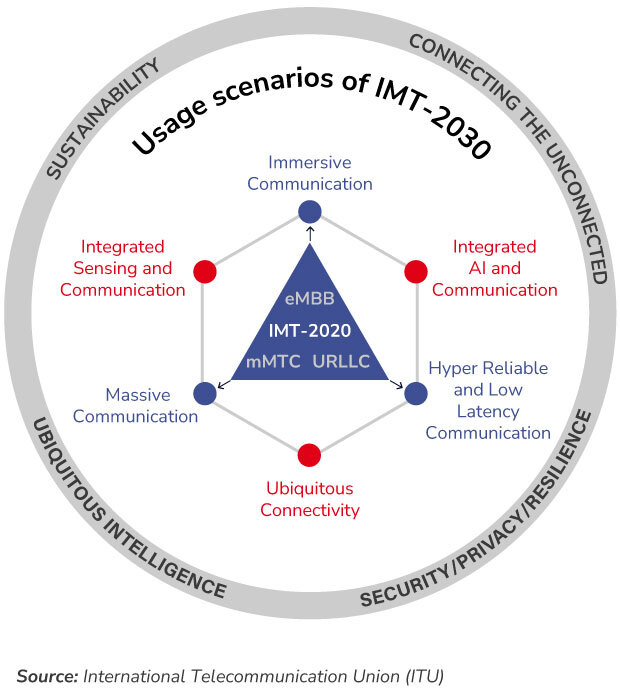
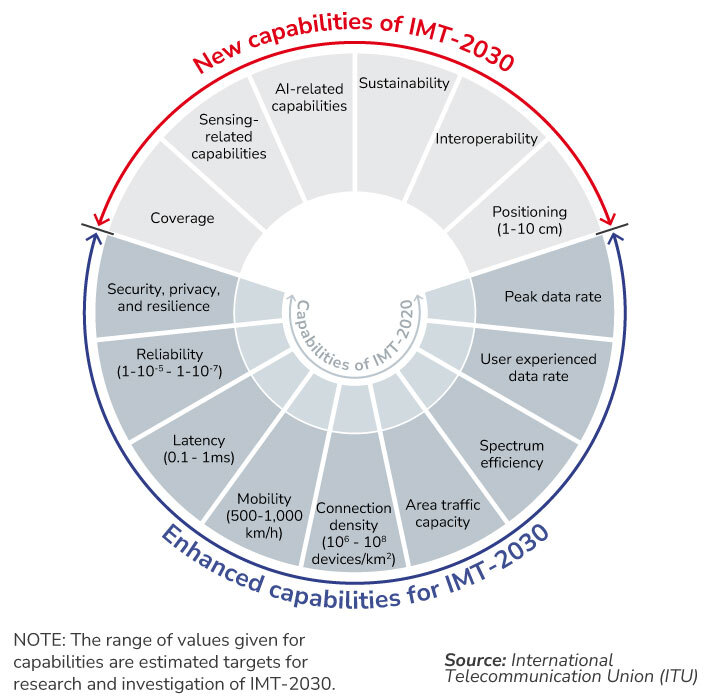
The Path to 6G
Understanding the mobile technology trends that are leading to 6G provides an opportunity to successfully integrate broadband industry requirements into the 6G architecture and design. Today, 3GPP is actively working on developing 5G Advanced, with certain features expected to bridge the evolution from 5G to 6G. The first specifications of 5G Advanced (Release 18) are expected in early 2024.
Some of the new 5G Advanced features include support for artificial intelligence (AI) and machine learning (ML), tighter integration between terrestrial networks (TNs) and non-terrestrial networks (NTNs), and improvements related to energy efficiency.
An example roadmap of 5G–6G, shown below, groups the new features into three categories: System Enhancements, Diverse Consumer Device Support and Different Radio Access Technology/Vertical Integration. The features will figure heavily into groups of projects, improving core performance, extending coverage of device types and expanding vertical sectors that incorporate mobile technology.
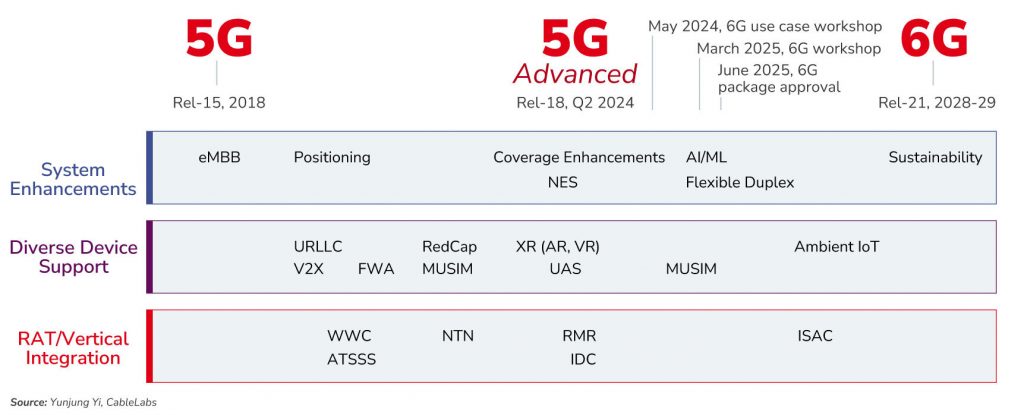
Here are a few examples of features in each category:
- System Enhancements. In each release, one or more features have been proposed and worked on to improve 5G system performance in consideration of various key performance indicators (KPIs). For example, 5G Advanced proposes positioning enhancements, coverage enhancements, AI/ML-based optimization for air interface/Next Generation Radio Access Network (NG-RAN), Flexible Duplex to address the uplink latency issue of Time Division Duplexing (TDD), and Network Energy Savings (NES). In 6G, we’ll see support for new advanced capabilities in the areas of sustainability, coverage, pervasive AI, interoperability and positioning.
- Diverse Consumer Device Support. One of the key differences between 5G and 4G is that 5G supports various consumer devices and diverse vertical markets. For example, Ultra-Reliable Low Latency Communications (URLLC) supports Industrial IoT devices such as robotics, machinery, automation, sensors and controllers. Vehicle-to-everything (V2X) technology supports vehicle, pedestrian and device-to-device communication between smartphones, wearables and drones. Reduced Capability (RedCap) devices support 5G connectivity with limited capabilities (e.g., lower data rate, bandwidth support) compared with normal smartphones. Fixed Wireless Access (FWA) supports a home gateway offering broadband services to home/customer premises. Multi-SIM capability supports the enhancement of devices with more than single-subscription information. Unmanned Aerial Systems (UAS) technology supports high-altitude aircrafts/airplanes. Extended Reality (XR) supports XR glasses, augmented reality (AR) devices and virtual reality (VR) devices; in fact, XR enhances the 5G network and RAN to support lower latency and more importantly lower jitter for multimedia. Moreover, 5G promises to extend its support for ambient IoT devices to the point at which ambient IoT device types will further reduce complexity compared with 4G Advanced’s Narrowband IoT (NB-IoT) support. In 5G and later, a device type considered in ambient IoT might have similar capability to Radio Frequency Identification (RFID).
- Different Radio Access Technology/Vertical Integration. The 5G standard also supports integrated/converged networking to various radio access technologies (RATs) and/or vertical sectors. For example, 5G supports integration with Wi-Fi networks — e.g., in-device coexistence (IDC) — to better manage resources, New Radio Unlicensed (NR-U) and Wi-Fi coexistence with mobile access. The 5G standard also supports fixed-mobile convergence architecture — for example, Wireless-Wireline Convergence (WWC). Moreover, starting in Release 17, satellite-based New Radio (NR) technology has been a key aspect of 3GPP in the form of NTNs. Recently, 5G Advanced has begun to investigate Integrated Sensing and Communications (ISAC) so that the first ISAC specification may be available in the Release 20 timeframe. Access Traffic Steering, Switching & Splitting (ATSSS) provides user data support over multi-access computing. Finally, Railway Mobile Radio (RMR) supports railway communication.
Mobile communications based on 5G/6G have devoted significant energy toward providing certain quality of service (QoS) levels to customer devices. In Release 19, 3GPP plans to further identify various users/devices sharing a subscription — say, 5G user equipment (5G UE) or 5G residential gateway (5G-RG) — and provide differentiated QoS to each user/device.
The graphic below illustrates various customer devices/device categories that the 5G/5G Advanced system supports — spanning various quality metrics and KPIs. For example, XR devices for AR/VR require very low latency (e.g., 1 ms) while handling high data rate demand (e.g., 100 Mbps – 1 Gbps). At the same time, due to the form-factor limitations of some XR glasses/equipment, a number of receiver antennas for a device may be limited as a result of required coverage enhancements compared with normal 5G UEs. In another example, reduced-capability devices will further decrease the number of receiver antennas and supported bandwidth (and thus require more coverage enhancement) but will offer improved energy-saving features (e.g., longer sleep) while relaxing QoS requirements. In 5G, more devices with higher capabilities (e.g., higher power, higher number of transmission/reception antennas) will support various verticals such as NTN, railway, aerial, fixed wireless gateway and so on.
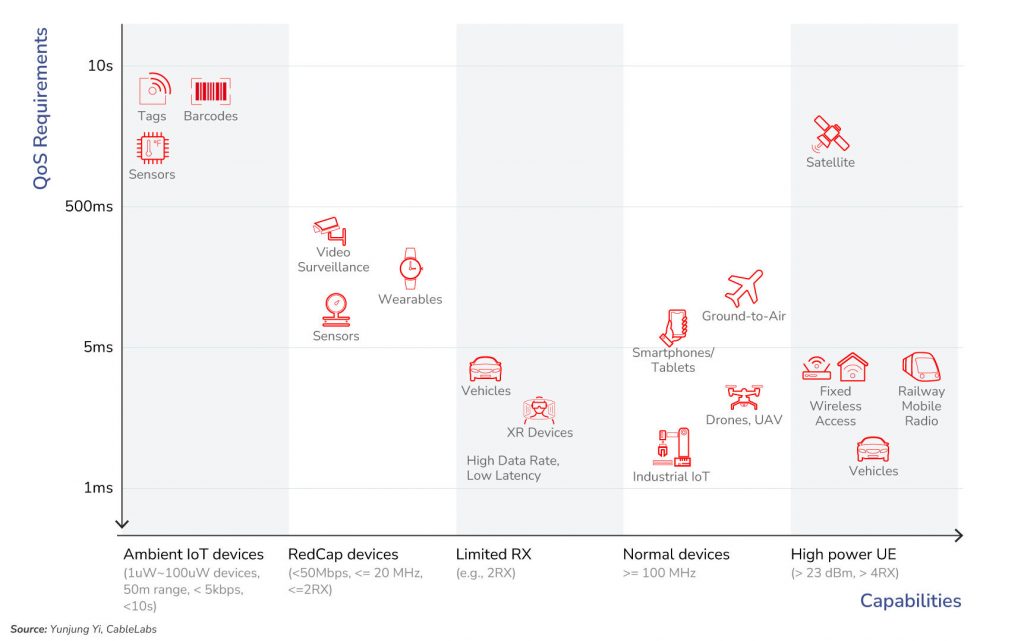
Support for a large variety of customer devices in a single system has both benefits and drawbacks. For example, 5G adopts the concept of network slicing to potentially alleviate some drawbacks in which each slice with partitioned resource/management supported different devices or verticals.
It is evident that mobile industry aims to expand its coverage to various industry sectors where the broadband industry currently holds sway. One consideration is to support broadband operation via FWA or NR-based NTN — at least, in some areas where fixed broadband may not be easily achievable. Another example is to support various sensors, video surveillance systems and home devices that have traditionally been supported by home Wi-Fi. The 5G/5G Advanced system not only supports various device types but also various spectrum/frequency options, such as unlicensed spectrum, lightly shared spectrum (e.g., CBRS band), licensed spectrum and satellite spectrum.
How 6G Matters to the Broadband Industry
Based on a recent technical report from ITU-R, 6G will reach for more integrated, highly automated and intelligent infrastructure that contains several operational domains in various types of network segments (e.g., wired/wireless access, core, edge and space segments). In the 6G network, an operator may potentially target a service provider offering an end-to-end system — that is, from application to customer, including transport.
Broadband industry operators might become connectivity operators, providing transport (or any segment of the 6G system), or service providers responsible for the entire end-to-end system. Either way, understanding 6G requirements and the trends of the mobile industry will be important to consider:
- The QoS management framework can be enhanced to support traffic requirements between various end customer devices and diverging end applications. For example, Packet Delay Budget (PDB) or Packet Data Unit (PDU) Set Delay Budget (PSDB) — for packets with inherent dependency on one another — may be supported in fixed networks to accommodate end-to-end delay requirements. Another example could be to extend network slicing or virtual/physical resource partitioning to support certain vertical applications or diverse QoS requirements.
- Identification and management of the end customer (e.g., user, application, device) can be enhanced to customize capabilities, necessary QoS requirements of the end customer and the corresponding cable network management/control plane. For example, subscription models of the cable network can be enhanced (e.g., via fixed-mobile convergence) to address the needs of certain end customers/devices/applications.
- The cable access network can be offered as a Transport as a Service (TaaS) option that can be integrated with various management/core networks. For example, the Service-Based Architecture (SBA) between 6G core network and various access networks — including cable access and mobile radio access — may be designed such that the 6G core can connect to cable access without requiring complicated gateway functionalities such as the Wireline Access Gateway Function (W-AGF). Further disaggregation of cable network functions could allow for flexible network topologies.
- To support sustainability, 6G design must transcend individual RAT energy-saving measures and adopt a holistic approach that includes cross-RAT/multi-access energy-saving features while providing a seamless user experience.
As noted, 6G is coming sooner rather than later.
Now is the perfect time to review lessons learned from the 4G and 5G experiences on multi-access integration (e.g., Wi-Fi interworking, WWC) and carefully consider 6G design choices and requirements from the beginning. Doing so will result in more efficient and simplified integration of the wireline and mobile industries, and will enable coverage of various industry sectors through integrated/automated converged mobile/wireline access networks.
If you would like to be a part of the discussion around 6G specification activity, contact me using the button below.


